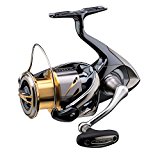Kelp Bass Feeding Information and Facts
Kelp Bass go for flies… fly fishing is a great way to catch Kelp Bass.
Common Food
Adult Kelp Bass feed on anchovies, sardines, surfperch, shrimp, queenfish, crustaceans and squid, while the young juveniles eat mostly plankton. Adults have two major feeding periods before and after the breeding season, which takes place from May to September.
Despite their namesake, Kelp Bass are not dependant or restricted to areas that contain kelp, often referred to as kelp forests, or even be anywhere near kelp. Like all bass, they can be found near underwater structures such as sewer pipes, old tires, oil platforms, chunks of sunken street cars, rock ledges, sunken logs and other underwater structures.
Young fry prefer to stick around the kelp, for protection and for food. However, there are many Kelp Bass populations that grow up outside of the kelp forests, but these are not considered ideal breeding grounds.
Kelp Bass are less likely to stay put if food cannot be found in their locale. And unlike other freshwater bass, the Kelp Bass will move to a new location during the day.
Lures
Good lures for catching kelp bass include the Big Hammer, Fish Trap and the Worm King. Unfortunately, the worm king is no longer being made, though it can still be found on ebay and other sites.
The Big Hammer was designed for the Kelp Bass in their habitat off the west coast of Mexico and California. The Big Hammer is very effective fishing lure when things are slow.
Seasonal Feeding
As the water temperature warms up in the spring, the Kelp Bass become more active and their appitite increases. They are most activie during the months between May and October.
Kelp Bass Population
Anglers are not catching Kelp Bass as large as they were 60 years ago. Research shows that global cooling leading up to the 1970s caused the kelp bass population to reduce at the same time as angling for kelp bass increased. Moreover, fishing for kelp Bass has turned into a large sport fishing industry.
While the state of California has placed a 10 fish limit on the Kelp Bass, there is a large push by many anglers to promote the cath and release program, especially for the large ones, which take a long time to grow and reach maturity. For example, by age six, the Kelp Bass is no more than 12 inches/30 cm long.
Fly Fishing for Kelp Bass
For some reason or another, people are surprised to learn that Kelp Bass go for flies and that fly fishing is a great way to catch Kelp Bass.
The best place to fish using flies are lagoons, estuaries and bay areas. Cold water slows down the bass but they will still strike a fly. Try the eel grass flats, from the transitional zones between the flats and the deepwater channels.
The best flies for catching Kelp Bass include poppers, divers, leeches, crayfish, pike and a range of baitfish.


